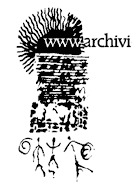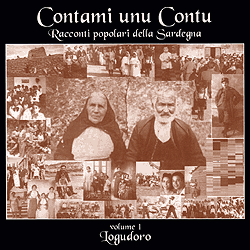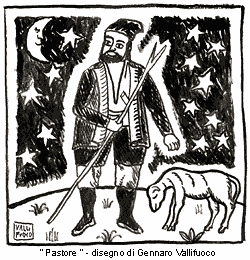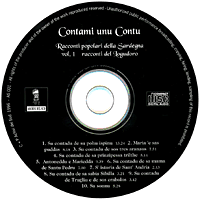
|

...The narrator escapes with a sort of instinctive craftiness from the lack of liberty in the popular tradition, from this unwritten law in which the people are conceded solely to repeat trite motifs: perhaps this person believes he is only creating variations on a theme, while in reality he ends up speaking about what is closest to his heart.
The technique with which the tale is constructed avails of both respect for the conventions and inventive liberty. Given the theme, a certain number of obligatory passages exist in order to arrive at a solution...it is up to the narrator to organise them, to hold them one above the other like bricks in a wall, rushing through the dead parts...using as mortar his limited or great art, that which the teller adds, the warmth of his places, trials and hopes, his own "content".
Italo Calvino


|
volume 1
Logudoro
A production of Archivi del Sud
In collaboration with the
Chair of History of Popular traditions
Of the University of Cagliari
With the contribution of
The Autonomous Region of Sardinia
Council for Public Education
Directors of the project:
Scientific consultants: Enrica Delitala and Chiarella Addari Rapallo
Sound restoration: Enzo Favata
Editing: Antonello Doro
General Co-ordination: Enedina Sanna
Marcello Peghin and Antonella Sanna
also collaborated
We thank the Società Umanitaria of Cagliari
|

Introduction
This present volume arises from research conducted by our Association starting in 1993 on the state of studies on popular narration in Sardinia. One of the aspects on which we have wanted to concentrate our attention is that of the sound material which already exists, the results of research carried out in the field in past years, which is interesting for various reasons: these are documents that underline the oral characteristics of narration and as a consequence the ability of the narrators. Today these would probably have been hard to find as a result of the social and linguistic transformations which have taken place. There is also the problem of verifying the state of conservation of the recorded media in order to intervene in time in the cases where there is the risk of irremediable loss of documents.
Given the contents of the research the establishing of contacts with the Chair of History of Sardinian Popular Traditions was natural as the department conserved records of the conspicuous work carried out in the 1970's. Thanks to the passion and interest of the lecturers Enrica Delitala and Chiarella Addari, who followed every phase of the project with the competence and care typical of their work, it has been possible to arrive at the production of this compact disc of tales from Logudoro, the first of a series dedicated to linguistically different areas of Sardinia.
We hope (and in this sense we continue to work) that this volume may be widely distributed, not only amongst researchers and experts, but also in schools as a didactic instrument for the language and as a reflection on an aspect of our culture which is certainly not marginal. This aspect appears today to be certainly compromised while not totally extinct. Finally, we would like to dedicate this work to all the "mastros de contanscias", masters in the art of narration - men and women who, within the community, had the 'useless' role of transforming moments of daily life, which were often fatiguing and repetitive, into pathways of fantasy on which the imagination of children and adults alike could travel.
Enedina Sanna
Archivi del Sud

Premise
The issue of this compact disc is situated within a larger project of
recuperation of traditional narrative texts elaborated by the Cultural
Association Archivi del Sud, in collaboration with the Chair of History of
Popular Traditions of the University of Cagliari. From the end of the 1960's
to the middle of the 1980's numerous graduation theses on the narrative
repertory of the oral tradition in Sardinia were presented to the Faculty of
Arts and Philosophy and to the Magistero, assigned by the professors Alberto
Cirese, Enrica Delitala and Chiarella Addari Rapallo. This body of research
led to the recording of popular texts in Sardinian, told by narrators, both
male and female, from various localities. This was analogous with that which
was carried out in 1968 for the Discoteca di Stato (the state record archive).
Today this material is of great importance, as we are in a moment in which the traditional tale and the use of the Sardinian language are in decline. Together with the material from the Discoteca di Stato, this is the only extensive and systematic survey (i.e. conducted on a regional level and with a uniform survey programme) which has been carried out in Sardinia.
 This compact disc, this first of a series, is of a character which serves as an example both of the narrative typologies which can be found within the corpus and of the possibility of reading and didactic use of the selfsame disc.
This compact disc, this first of a series, is of a character which serves as an example both of the narrative typologies which can be found within the corpus and of the possibility of reading and didactic use of the selfsame disc.
It presents ten texts in the dialect of Logudoro selected from around two hundred which were recorded between 1970 and 1975 in various towns in the province of Sassari. We have tried to display the various plots and different categories of tale while remaining within the limits imposed by the duration of the CD. In choosing the texts, preference has been given to the most capable and vivacious narrators, with good communicative capacity and, bearing in mind the advanced age of the majority of those interviewed, good diction.
In the general elaboration of the recuperation project of all the inquiries into fables and in the realisation of the first trial disc, we were guided by the will to save the recordings the state of conservation of which were in danger, and to put at the disposition of as many people as possible that which before could only be consulted by those directly concerned with the work. We were guided by the will to solicit didactic use (at all levels) of the tales linked to the oral tradition and to stimulate the memories of the holders of this great cultural heritage.
It is not superficial to underline yet again the central nature of the disc
and the instrumentation of the volume of the listening guide; this is no
homage to the current refined technology in the reproduction of sound, but
rather of a shift in the form of communication, of tale techniques and
literary styles, of ways to transmit knowledge and concepts which are
specific to the traditional world, based on oral communication and manual
work, on expressions which allow us to understand better the cultural fields
in which writing was limited and of secondary importance in comparison to
the word and gesture.
Oral story-telling was once part of daily life and one of the means for socialising, for communicating one's experiences to others, to inform of what was happening locally, or in other parts of the world, to interpret the past, to create an understanding of the supernatural, to diffuse what was learnt in books.
Amongst the domestic walls, in moments of rest, in neighbourhood meetings outdoors, in the bars, during the activity of bread-making or spinning and crochet, at the laundry and at the river, in the fields, in the mangers, at the festivals, during hunting, in all the occasions of meeting, people chatted and expressed themselves and the informal discussions alternated with realistic stories and fantasies, which were formally constructed and handed down from generation to generation.
In the 1970's, when urban culture was invading the traditional systems, when the growth of the average level of education and diffusion of radio and television communication were opening new doors upon the world, the traditional tale was passing through a crisis: the religious legend, the mythical tale, the magic tale, the simple and naive stories appeared to be windows upon a closed world, out of date and often contested. These were far from the new dreams and new aspirations and were not able to explain reality.
This is the result of the survey campaigns of Maria Becciu in Anela, Bono and Bultei in 1970 and 1971, by Maria Manunta in the same years at Nughedu San Nicolò, Ozieri, Pattada and Tula, and by Maria Teresa Riu in Villanova Monteleone between 1973 and 1975. This result has been confirmed by other studies carried out in other Sardinian regions.
Memory lapses which are betrayed on some of the texts of the disc are clearly linked to the rare habit of story-telling and listening to stories, in the selfsame linguistic blending of archaic terms with Italian words, which denote a passage from a closed traditional system to a form of gaining culture which was not always positive.
The narrators, both male and female: Peppina Falconi from Ozieri, Raimonda Mameli from Bono, Bonaria Manca from Ozieri, Raffaella Meloni from Villanova Monteleone, Mattia Mugoni from Bultei, Giuseppe Murtinu from Ozieri, Virginio Pani from Nughedu San Nicolò, Salvatore Secchi from Nughedu San Nicolò from Antonia Zarru from Bultei narrate in an artificial situation and not in a free and spontaneous narration session; yet the joy of narrating and the seriousness of the communicative act are almost always transparent: after the first uncertainties the narrator forgets the recorder and the interviewer, and identifies him or herself in the tale and is drawn by the desire to astonish and immerse an imaginary public in a world of
fantasy.
As we have said, this is only a guide to the listening. Those who desire more precise and exhaustive information on problems relating to narration will find below an essential bibliography.
f each text we provide an orthographic transcription and a literal translation. In the transcription we have avoided using diacritics mainly for typological reasons, and we have aligned the text to Italian standards as much as possible; we indicate the postvelar fricative with h (pohu), and with ith and idh the aspirated and palatalised sounds specific to Northern Logudoru (cultha); furthermore in the transcription we have tried to respect the oral nature of the text as much as possible, indicating syntactic phonetics, elision, truncation, paragogic vowels etc.
Each text is preceded by a brief list in which the following information is presented in this order: date and locality of collection; essential information about the narrator; details of the collector and indication of the pages of the thesis in which the tale is discussed (Becciu: Maria BECCIU, Traditional Narration in Goceano, Cagliari, year 1970-71; MANUNTA: Maria MANUNTA, Traditional narration in Logudoro, Cagliari, year 1970-71; RIU: Maria Teresa RIU, Survey of the traditional tale in Villanova Monteleone, Cagliari, year 1975-76); indications of the international classification (AT: Aarne and
Thompson, Types...; motif: THOMPSON, Motif-index....).
We thank the authors of the inquiries and theses which have constituted the basis of this work and above all those who told the tales, to whom thanks must be given for the fact that traces will remain of this priceless linguistic and folklore heritage.
Enrica Delitala
Chiarella Addari Rapallo
University of Cagliari

Annotations about the sound restoration
The copying from reels or magnetic tape to DAT cassettes was carried out by the undersigned in the musical workshop of Archivi del Sud.
Reel recorders UHER and REVOX, which were in use in the period of the surveys, were utilised.
In the passage from original tape to DAT, the following filter was applied: octave subtracting parametric equaliser - model DBX project 1.
In general the conservation of the material was good: only some of the recording displayed irrecoverable alterations due to use or time: it must be added that recordings on reel, while preceding audiocassettes, are without doubt of superior quality and therefore create fewer problems for recuperation.
Microphone distortions were present on many recordings, as well as noises due to the microphone being hit and the hum of the recorders, have been partly eliminated, as has the hiss caused by the movement of the tape upon the tape heads.
Some phases of restoration were carried out with the help of the composer Antonello Doro, by way of the Mackintosh Centris calculator with the use of the Audiomedia card II, some of the Sound Designer II filters and other software.
An interesting factor is that once the hisses and hums were eliminated, the sounds of the environment surrounding the recording emerged, as well as the voice of the narrator, the sound of the rooms of the past could be heard, the mechanical alarm clocks, the sounds of a courtyard in spring, the passing of the old buses, the shouts of children in the streets.
Who could have imagined that the technology of the future would have been able to give us back the sounds of our memory once more?
Enzo Favata

The tales
 The tales of the Logudoro
The tales of the Logudoro
1. Su contadu de su pohu ispinu (13.24)
2. Maria 'e sas puddas (8.18)
3. Su contadu de sos tres aranzos (7.51)
4. Su contadu de sa prinzipessa trilthe (5.14)
5. Antoneddu e Mariedda (9.39)
6. Su contadu de sa mama de Santu pedru (7.00)
7. S'istoria de Sant'Andria (2.13)
8. Su contadu de sa sabia Sibilla (3.21)
9. Su contadu de Trugliu e de sos crabolos (3.42)
10. Su sonnu (5.28)
Click here for read or listen the track in Real Audio

Copyright © 1990-2000 Archivi del Sud - All rights reserved
|










![]()

![]()
![]()
 This compact disc, this first of a series, is of a character which serves as an example both of the narrative typologies which can be found within the corpus and of the possibility of reading and didactic use of the selfsame disc.
This compact disc, this first of a series, is of a character which serves as an example both of the narrative typologies which can be found within the corpus and of the possibility of reading and didactic use of the selfsame disc.![]()
 The tales of the Logudoro
The tales of the Logudoro![]()